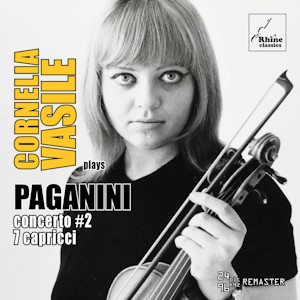
Niccolò Paganini (1782-1840)
Violin Concerto No.2 in B minor, Op.7 “La campanella”
24 Caprices for solo violin, Op.1 Nos. 1, 4, 5, 9, 11, 13, 24
Cornelia Vasile (violin)
rec. live, 20-21 November 1969 (Op. 7); 21 January 1970 (Op. 1), Hamburg, Germany
Rhine Classics RH-032 [54]
Cornelia Vasile’s name was only known to me because of a hoax. This was the deception that a violinist called Giuseppe Gaccetta – a Paganini fantasist and obsessive – had recorded some Paganini Caprices back in 1932. Taking Vasile’s DG recording of a selection of them and crudely simulating a recording of the time, the recording fooled some people until Ingolf Turban exposed the fakery. Until now, however, I’d never heard any of her recordings.
She was born in 1948 in Timisoara in Romania and made quick progress, making her concerto debut at the age of nine, graduating from the conservatoire in Bucharest. She went to an Ivry Gitlis masterclass in Salzburg in 1969 and he remained an admirer, grandiosely claiming on her LP that ‘She plays better than Milstein and Szeryng together’. Good publicity, certainly. He recalled her in a chapter in his book L’âme et la corde. She remained in Germany joining the Graunke Orchestra with which she played concertos. However, she missed concerts and, as E.R. Schliephake, a former violinist of the Munch Symphony and Graunke Orchestra, relates in the booklet notes, she had to resign from her orchestral position. Her career never developed, and she lived on social welfare. She eat unhealthily, gaining weight – an eating disorder probably reflecting her mental frailty. She died in Munich in 2010.
She sems to have been admired by many critics. Joachim Kaiser called her ‘a natural phenomenon’ and Henry Roth – who had, I assume, never heard her – included her in a list of promising young players in his book on violinists. She seems to have been so closely identified with Paganini that there was little room for repertorial manoeuvre, though there’s a reference in the notes to a performance of Lalo’s Symphonie espagnole. In the studio she recorded Kurt Graunke’s Perpetuum mobile with the Graunke Symphony under the direction of the composer on the Sedina label, all the Paganini Caprices for Electrecord, and then a selection of them for DG coupled with Ysaÿe’s Sonata No.2 – this is the DG LP mentioned by E.R. Schliephake in his notes.
Who can say what went wrong? All that’s left is a small legacy of recordings augmented by this Hamburg recording of Paganini’s Concerto No.2, with her own cadenza, taped in 1969 with the North German Radio Symphony Orchestra directed by Heinz Wallberg. She is as admirable an exponent as the critics wrote. Dextrous, technically controlled, and robustly virtuosic she is thoroughly inside the music tossing off its many difficulties with nonchalant ease. There’s a bit of spread in the recording acoustic but nothing diminishes the glamorous dispatch of her performances. Her legato is excellent, and she characterises well. Maybe the finale is not quite as fiery as it can be but it’s still a fine, well-coordinated performance in all respects.
The selection of Caprices is from a studio performance not from the DG recording and dates from January 1970. She shows her formidable qualities here once again in seven of them, Nos. 1, 4, 5, 9, 11, 13 and 24 and is generally quicker than a benchmark historic performance of mine, the cycle of the Czech violinist Iwan Kawaciuk, made for Supraphon.
Gitlis said that Vasile was something of a ‘wacky character’. It’s also alleged that she made a suicide attempt. Unable or unwilling to hold down a position in a symphony orchestra she was also not able to make a mark on the concert circuit as a soloist, a place for which her instrumental gifts had equipped her. Other gifted players have survived. Her almost exact Romanian contemporary, Silvia Marcovici, for example, also studied at the Bucharest Conservatory, won success at sixteen and went on to an admirable career and is now a professor in Graz.
Perhaps other broadcasts survive showing her in other, more standard repertoire. What was she like in Mozart and Brahms, if she played these concertos, and in sonatas? It’s hard from this ultra-virtuosic repertoire to get a grip on her temperament and her musicality. Until then she will remain a not-uncommon example of a talent seemingly unfulfilled.
Jonathan Woolf
Previous review: Stephen Greenbank (July 2024)
Availability: Rhine Classics


















